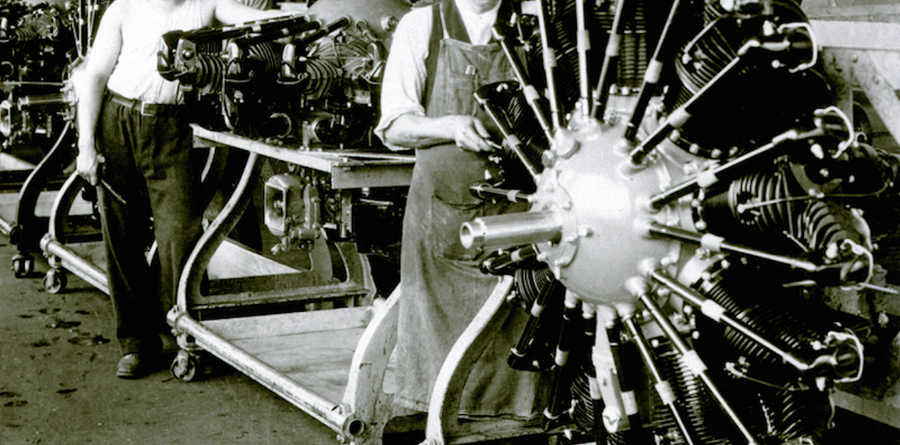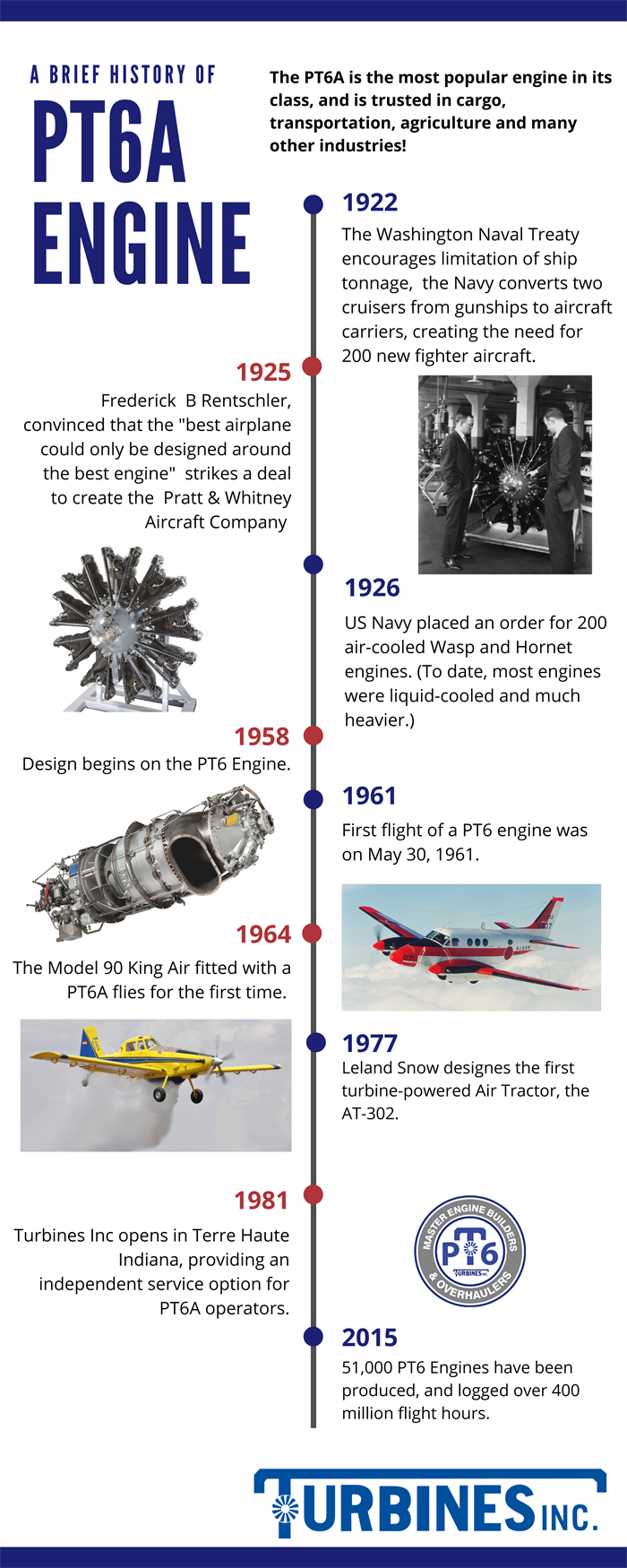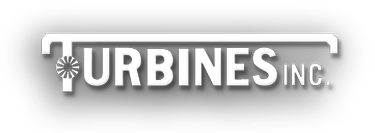A Brief History of the PT6A Engine

It's hard for us to imagine life before the PT6A engine, but here's a brief history of some of its famous predecessors.
57.7 KB - View full size - Download
Before the PT6A
In 1902, the Wright Brothers were already seeking better engines for their newborn aircraft. It was clear that for flight to be practical, they needed more power, from a lighter, more durable engine that was easier to maintain. That’s been the quest in the industry since that time.
Charles Taylor helped them develop a 12 HP engine that weighed 170 pounds, including the water in the radiator and 1.5 gallons of gas.
It had no throttle. The four-stroke engine always ran at about 1,000 rpm. But output could be somewhat controlled by retarding or advancing the spark timing.
Other engine features included:
- Non interchangeable components. Each was hand fitted. A piston, for example, only fit in the cylinder it was built for.
- The crankcase, cylinder water jacket, mounting lugs, and part of the intake manifold were cast as a single piece of aluminum.
- Valves were cold-rolled steel and of the poppet type. Piston suction opened the inlets and exhaust valves operated on a bicycle chain and sprocket-driven camshaft.
- Fuel dripped into the intake manifold where it was vaporized by the hot water jacket and sucked through the inlet valve and into the cylinders.
- Time between overhauls was about 12 hours.
Advances in engine technology occurred over the next 100 years, spurred by developments in other industries. Some of the biggest advances occurred as a result of wars and conflicts that provided defense industry spending.
This timeline provides a brief history of engine types with examples of each:
Famous Firsts:
- 1903 Wright Flyer (4-cyl): First engine to fly
- 1916 Lawrence A-3 (2-cyl): First U.S. opposed air-cooled engine
- 1926 Cirrus Mk III (4-cyl): British inline used for private aircraft
- 1930 Aeronca E-107 (2-cyl): First widely used U.S. opposed engine
- 1931 Continental A-40 (4-cyl): Ancestor of current opposed engines
- 1941 Ranger 6-440 (6-cyl): Final evolution of air-cooled inline engines
- 2003 Teledyne CAE IO-550-N (6-cyl): Latest opposed engine
V-type piston engines
- 1916 Curtiss OX-5 (8-cyl): Early US V-8.
- 1917 Liberty L-12 (12-cyl): First to fly the Atlantic, cross the U.S., and circle the globe
- 1932 Curtiss Conqueror (12-cyl): Typical V-12 of the 1930's
- 1939 Ranger SGV-770 (12-cyl): Rare U.S. inverted, air-cooled V-12
- 1940 Allison V-1710 (12-cyl): Most highly developed U.S. V-12
Radial and rotary piston engines
- 1911 Anzani (6-cyl): First two-row radial engine
- 1916 Le Rhone 9C9 (9-cyl): Rotary engine used in WW I fighters
- 1924 Wright J-4 Whirlwind (9-cyl): First successful U.S. radial
- 1950 Pratt & Whitney R-4360 (24-cyl): Largest U.S. radial
- 1958 Bristol Centaurus (18-cyl): Last large British radial
Gas turbine engines
- 1943 Junkers Jumo 004 turbojet: First jet engine used in combat
- 1943 General Electric I-16 turbojet: First U.S. production jet engine
- 1947 General Electric J35 turbojet: First U.S. production axial-flow jet
- 1955 Klimov VK-1F turbojet: Last large centrifugal-flow engine
- 1965 Allison T63 turboshaft: Popular small gas turbine
- 1971 Pratt & Whitney TF30 turbofan: First afterburning turbofan
- 1974 Teledyne CAE J69 Turbojet: Ultra-compact cruise-missile engine
- 1975 General Electric TF34 turbofan: First mid-size high-bypass turbofan, still in production for regional jets
How does the PT6A Fit?
The PT6a is a gas turbine engine that is incredibly reliable and versatile.
It’s easily recognizable because it looks “backwards” has proven to be a key attribute to its success: its rearward, reverse flow inlet and forward facing turbine section providing fast maintenance turn-around through on-wing hot section refurbishment in most aircraft installations. The PT6A is a two-shaft engine with a multi-stage compressor driven by a single-stage compressor turbine and an independent shaft coupling the power turbine to the propeller through an epicyclic concentric reduction gearbox. (AKA “planetary gear train.”)
The PT6A is the only engine to achieve Single Engine Instrument Flight Rules (IFR) status for passenger revenue activity in North America, Australia, Europe and New Zealand.
It’s designed to be easy to maintain. All external components are designed for easy access. On-wing maintenance is possible for most tasks, where other engines might need a shop visit.
How did this durable, versatile engine come to be?

It's hard for us to imagine life before the PT6A engine, but
here's a brief history of some of its famous predecessors.
152 KB - View full size - Download
The Story of the Pratt & Whitney
In 1922, (just 17 years after the Wright Flyer’s 14-horsepower four cyclinder engine!) Frederick B. Rentschler suggested to the Navy that he could meet their standard for a 400 horsepower engine weighing 650 pounds or less.
Rentschler was a former Navy Lieutenant. His opportunity was the result of the 1922 passage of the Washington Naval Treaty, the result of a five-nation negotiation to disarm the major naval powers of the world. The treaty limited the construction of war ships by limiting ship tonnage. With two large battle cruisers already in production, the United States Navy decided to conform to the treaty by converting the two cruisers from gunships to aircraft carriers, thereby creating an immediate need for 200 fighter aircraft with which to stock the carriers.
A graduate of Princeton University, Rentschler came from an industrious Midwest family with social connections, and through his banker brother soon learned that the Pratt & Whitney Machine Tool Company of Hartford, with its long history as a manufacturer of precision tools, had both capital to invest and extra factory space. As it happened, the president of Pratt & Whitney’s parent company, Niles-Bement-Ponds, was a friend of the Rentschler family, and with little fuss a deal was struck in July 1925 creating the Pratt & Whitney Aircraft Company as a separate business with Rentschler at the helm.
Wasp and Hornet Feature Innovative Air-cooled Radial Design
Rentschler’s vision centered on the design of an efficient, air-cooled radial engine.
At that time most engines were like auto engines, cylinders in line, cooled by water and cooling fluid like glycol. Although some were excellent performers, they tended to be heavy with the extra weight of plumbing and coolant. There were those, especially the fledging aviators of the U.S. Navy, who believed an air-cooled radial engine was an alternative. These engines would be more compact, easier to maintain without the liquid cooling hardware and also more reliable without the radiators, pipes, hoses, pumps and tanks. They could take the pounding of carrier landings.
By Christmas, Rentschler and his team had produced an ingenious radial design that was rugged and easy to build. The one-piece master connecting rod was fitted around a two-piece crankshaft. This greatly strengthened the highly stressed master rod that transmitted the full power of all nine cylinders to the crankshaft, allowing a service rpm as high as 2400. The crankcase was a two-piece forging, lighter and stronger than the traditional casting design. Because the overall design cut down on weight, the engine could be bigger – 1340-cubic-inch displacement compared to 1140 cubic inches in a competing Wright design. Rentschler’s team even figured out a way to machine cylinder-cooling fins from a solid block so they would be thinner and more could be fitted to each cylinder.
The result was an engine that produced 425 horsepower while weighing only 650 pounds.
Searching for a name for the engine from among the family of fast-flying insects, Rentschler’s wife suggested the “Wasp.” Soon after, Rentschler’s team had produced a second air-cooled radial named the “Hornet” that was rated at 525 horsepower, and by October 1926 the US Navy had placed an order for 200 Wasp and Hornet engines, thereby insuring the short-term financial success of Pratt & Whitney Aircraft.

A worker on the final assembly of a WASP engine in the East Hartford plant. 1940
108 KB - View full size - Download
WWII Brings Dramatic Growth
The dependability of the Wasp and the Hornet also made them popular among commercial aircraft manufacturers, and as the manufacturing of airplanes for commercial use increased, so did the demand for Pratt & Whitney engines. Meanwhile, continued demand for more powerful engines for military use added to the company’s prosperity. To keep up with production, the company moved its operations in 1929 to a large new plant it built in East Hartford on a 1,100-acre site, which included an adjacent airfield for flight testing its aircraft engines. The airport was soon named Rentschler Field.
By 1940, Pratt & Whitney’s engine technology had improved dramatically. The company’s largest engine, the Twin Wasp, produced 1,200 horsepower. As President Franklin Delano Roosevelt moved to put the country on a wartime footing, American aircraft manufacturers were called on to produce 50,000 aircraft a year for the military. To meet the challenge, Pratt & Whitney by 1943 expanded its workforce from 3,000 employees to 40,000. The company also recruited automakers, including Ford, Buick, and Chevrolet, as subcontractors, training the auto companies to duplicate the Pratt & Whitney manufacturing process.
Pratt & Whitney engineers continued to innovate, increasing the power of their engine designs throughout the war years. By the end of the war, the power of Pratt & Whitney’s largest engine had tripled to 3600 horsepower, and the company and its licensees had managed to produce more than 363,000 aircraft engines, an amount equal to one half the total air power of the Allied Air Forces.
In the post-war years, the company adapted to the modern air age with the manufacture of jet turbine engines beginning in the 1950s. Today, as part of the United Technologies Corporation, Pratt & Whitney continues to be an innovative manufacturer of jet turbines for commercial and military use worldwide, as well as one of Connecticut’s larger employers.
The PT6 Engine – Designed in 1958
The Pratt & Whitney Canada PT6 is a turboprop aircraft engine produced by Pratt & Whitney Canada. Its design was started in 1958, it first ran in February 1960, first flew on 30 May 1961, entered service in 1964 and has been continuously updated since, building on the need for a light, durable engine that is easy to maintain.
It consists of two basic sections: a gas generator with accessory gearbox and a free power turbine with reduction gearbox, and is often seemingly mounted backwards in an aircraft in so far as the intake is at the rear and the exhaust at the front.
Many variants of the PT6 have been produced, not only as turboprops but also for helicopters, land vehicles, hovercraft, boats, as auxiliary power units and for industrial uses.
By November 2015, 51,000 had been produced, had logged 400 million flight hours from 1963 to 2016. It is known for its reliability with an in-flight shutdown rate of 1 per 651,126 hours in 2016.
The PT6A covers the power range between 580 and 1,940 shp (430 and 1,450 kW) while the PT6B/CT are turboshaft variants for helicopters.
Aircraft that Use the PT6A
- AASI Jetcruzer
- Aero Commander 680T (PT6 conversion)
- Aero Ae 270 Ibis
- AHRLAC Holdings Ahrlac
- Air Tractor AT-400
- Air Tractor AT-501
- Air Tractor AT-602
- Air Tractor AT-802
- Antilles Super Goose
- Antonov An-28
- Ayres Turbo Thrush
- Basler BT-67
- Beechcraft 1900
- Beechcraft Model 99
- Beechcraft A36TC Bonanza (turbine conversion)
- Beechcraft C-12 Huron
- Beechcraft King Air
- Beechcraft Lightning
- Beech 18 series (turbine conversion)
- Beechcraft Model 87
- Beechcraft Model 99
- Beechcraft RC-12 Guardrail
- Beechcraft RU-21C Ute
- Beechcraft Starship
- Beechcraft Super King Air
- Beechcraft T-6 Texan II
- Beechcraft T-34C Turbo-Mentor
- Beechcraft T-44 Pegasus
- Beriev Be-30K
- CASA C-212 series 300P
- Cessna 208 Caravan
- Cessna P210N (turbine conversion)
- Cessna 404 Titan (turbine conversion)
- Cessna 421C Golden Eagle (turbine conversion)
- Cessna 425 Corsair/Conquest I
- Conair Turbo Firecat
- Conroy Tri-Turbo-Three
- de Havilland Canada DHC-2 Mk. III Turbo Beaver
- de Havilland Canada DHC-2T Turbo Beaver[37]
- de Havilland Canada DHC-3 Otter (turbine conversions)
- de Havilland Canada DHC-6 Twin Otter
- de Havilland Canada Dash 7
- Dominion UV-23 Scout
- Dornier Do 128 Turbo Skyservant
- Dornier Seawings Seastar
- Douglas DC-3 (turbine conversions)
- Epic LT Dynasty
- Embraer EMB 110 Bandeirante
- Embraer EMB 121 Xingu
- Embraer EMB 312 Tucano
- Embraer EMB 314 Super Tucano
- Frakes Mohawk 298
- Frakes Turbocat
- Gulfstream American Hustler 400
- Grumman Mallard (turbine conversion)
- Grumman Goose (turbine conversion)
- Harbin Y-12
- Helio AU-24 Stallion
- IAI Arava
- IAI Eitan
- Indonesian Aerospace N-219
- JetPROP DLX
- Kestrel K-350
- KAI KT-1
- Let L-410 Turbolet
- Lancair Evolution
- NAL Saras
- NDN Fieldmaster
- FTS Turbo Firecracker
- PAC 750XL
- PAC Cresco
- Piaggio P.180 Avanti
- Pilatus PC-6/B Turbo-Porter
- Pilatus PC-7
- Pilatus PC-9
- Pilatus PC-12
- Pilatus PC-21
- Piper PA-31P (turbine conversion)
- Piper PA-31T Cheyenne
- Piper PA-42 Cheyenne III
- Piper PA-46-500TP Meridian
- Piper T1040
- PZL-130T Turbo Orlik and PZL-130TC-II Orlik
- PZL M-18 Dromader (turbine conversion)
- PZL M28 Skytruck
- Quest Kodiak
- Reims-Cessna F406 Caravan II
- Saunders ST-27/ST-28
- Scaled Composites ATTT
- Shorts 330
- Shorts 360
- Short C-23 Sherpa
- Socata TBM
- Spectrum SA-550
- Swearingen SA26-T Merlin IIA
- TAI Hürkuş
- US Aircraft A-67 Dragon
Modern PT6A Engines
Since the Wright Brothers and Chuck Taylor started their quest for lighter, more durable aircraft engine that was easier to maintain, hundreds of engines have been introduced to the market.
But none has been as popular and versatile for general aviation as the PT6A.
While the PT6A engine is relatively easy to service, operators depend on their aircraft for their businesses and livelihood. A need for quick, reliable engine overhauls, turbine inspections, and other services was growing. And in the spirit of free enterprise and independence from any one solution, many operators wanted more options.
Turbines Inc was started in 1981 by Jim Mills in Terre Haute, IN. The business was based on knowledgeable people, fast turn times, and fair prices.
The company has grown over the years and now services business aviation, cargo, AND agricultural aircraft from all over the world. Its values remain the same. Many of the employees have been here 25+ years. The depth of our experience and knowledge is unequalled in any Turbine shop. We believe in employing our veterans . 80% of our shop employees were in the military.
Turbines Inc has developed many STC’s including Turbine conversions for the Ag-Cat, Brave and Dromader. And the list keeps growing.
The company performs quick and quality PT6a engine repair and overhaul, hot section inspections, prop strikes, power section repair, unscheduled inspections, agricultural plane repair, PT6a-28 to PT6a-34 conversion and other conversions.
Turbines Inc is one of the few shops that has expertise with the PT6A-20 engine. Turbines Inc is privately owned, so there are no committees or red tape to go through.
At Turbines Inc, the PT6A has been our specialty for forty years. We’re proud to be included in this exciting time in aviation history!

